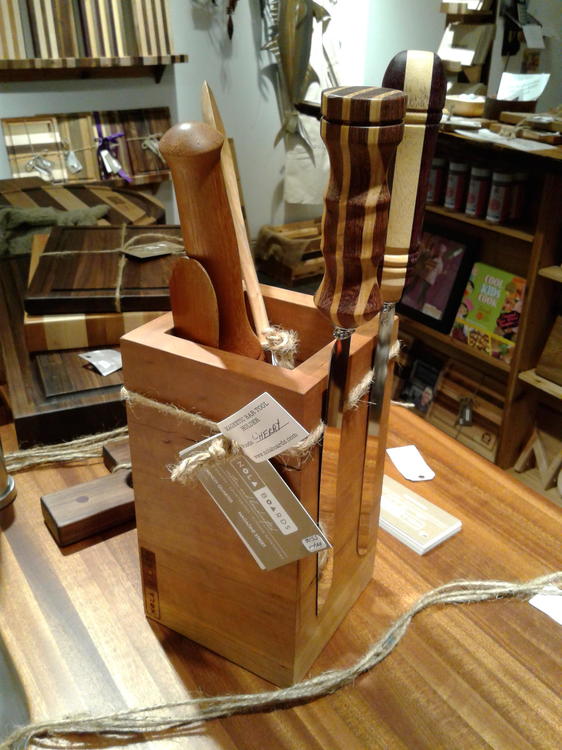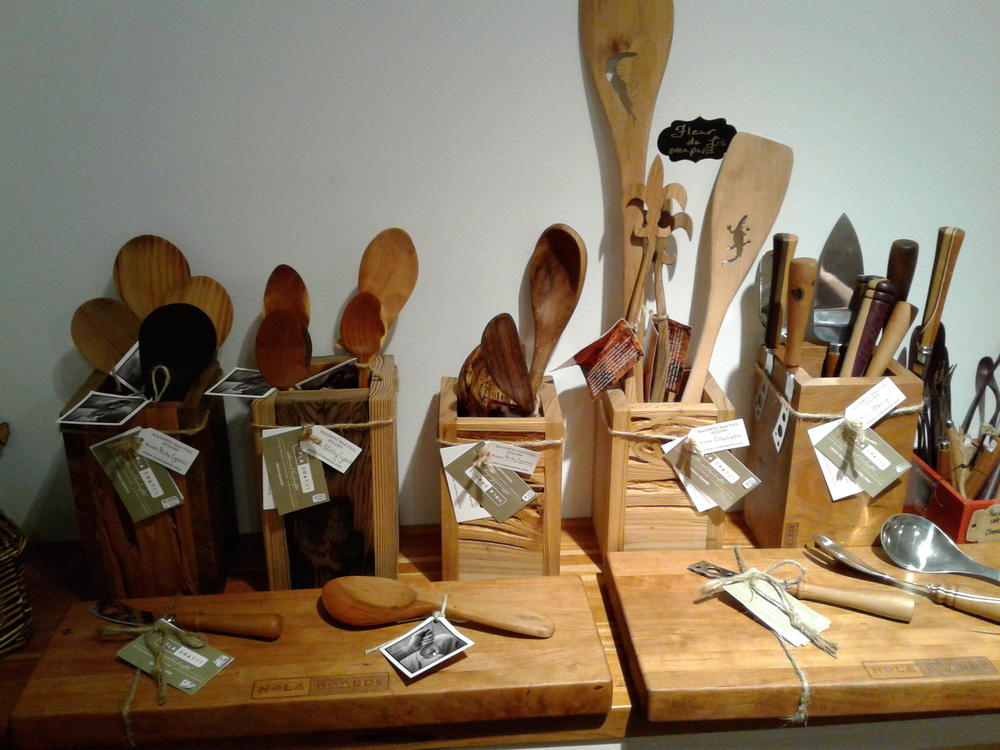
boilsover
participating member-
Posts
918 -
Joined
-
Last visited
Content Type
Profiles
Forums
Store
Help Articles
Everything posted by boilsover
-
What is the capacity of the Demeyere you're looking for? Is it clad or disk-base?
-
Try https://www.zwillingonline.com/8016.html $89 isn't a great price. I think I paid closer to $50. The basket alone is worth $50 if it fits something else you have. The fine mesh makes short work of mirepoix, bouquet garni, and stock bones without ladling. It's also a very good deep fryer that economizes on oil. Fissler's loop handles are good. The stick handles I find weirdly clammy/slippery and unergonomic, but they hardly heat up at all. Is your 8" hob gas? This would be a problem...
-
Sorry, I was responding to your statement: "I found tall stockpots less than 9 liter are like hens' teeth. Supposedly Demeyere makes one, but not one that I could find to buy." So I pointed out 2, including the Demeyere. If a 6Q thin SS is too heavy, I see no alternative but to go smaller. The Demeyere is 4.8Q, BTW. FWIW, I was comped one of the 3Q Housecopper stockers to review, and it's actually quite useful for back-of-the-stove/continuous kitchen use. I've been after the company to offer a pasta/blanching insert for it. If you like Fissler, you should check out the prices at the Spanish eBay--MUCH cheaper.
-
You might try the Demeyere "asparagus pot" from their Resto line. Tall, light and cheap. My only issue is that the disk diameter is too small for most gas hobs, so you can get some Ring-of-Fire effects with things like milk. There's also this: https://housecopper.com/product/3-quart-copper-pot/ Not cheap, but also pretty light.
-
I believe Woll is PTFE with diamond powder added.
-
Coincidence? It could have been the fumes from the Scotch brand tape!!!
-
It's in 3M's earliest studies. I'll see if I can find it again. Generally, under 400F, PTFE is quite stable, and biologically unavailable. Above that, it becomes progressively unstable, volatile and toxic. The byproducts of pyrolized PTFE (e.g., C8) can be highly lethal. Even short of perceptible burning, PTFE emits ultrafine paticulates which can cause respiratory problems. IMO, this is the threshold for the market warnings not to exceed 500F.
-
Absolutely. I believe Teflon on the stovetop is an accident waiting to happen. There is a partial safety feature for pans used on induction: manipulation of the pan's Curie Point. Demeyere's ControlInduc is one example, but IMO the chosen cutoff point is still too high.
-
3M's own data say PTFE begins off-gassing at about 400F. Consumers are told 500F because that's the point where the plastic starts degrading in earnest.
-
Thanks. I wonder how/why they picked 1%. Somehow we morphed from "NO! NO one EVER uses it!!!" and "APPALLED", to "It's not the best." I never said H2O2 was the best for rinsing vegetables. Yet It clearly has some efficacy as a sanitizer. And it is a good general-purpose household chemical to have on hand for many uses. If it's what you have, and it has efficacy, it's hard to get to the shrill "APPALLED". Just so folks can see what FDA says about H2O2's efficacy: "Use of H2O2 on whole and fresh-cut produce has been investigated in recent years. Salmonella populations on alfalfa sprouts were reduced approximately 2 log CFU/g after treatment for 2 min with 2% H2O2 or 200 ppm chlorine (Beuchat and Ryu 1997). Less than 1 log CFU/g reduction was observed on cantaloupe cubes under similar test conditions. Treatment with 5% H2O2 bleached sprouts and cantaloupe cubes. Treatment of whole cantaloupes, honeydew melons, and asparagus spears with 1% H2O2 was less effective at reducing levels of inoculated salmonellae and E. coli O157:H7 than hypochlorite, acidified sodium chlorite or a peracetic acid-containing sanitizer (Park and Beuchat 1999). Use of a 1% H2O2 spray on alfalfa seeds and sprouts did not control growth of E. coli O157:H7 (Taormina and Beuchat 1999b). H2O2 (3%), alone or in combination with 2 or 5% acetic acid sprayed onto green peppers, reduced Shigella populations approximately 5 log cycles, compared to less than a 1-log reduction by water alone (Peters 1995). In the same study, Shigella inoculated onto lettuce was reduced approximately 4 log after dipping in H2O2 combined with either 2 or 5% acetic acid; however, obvious visual defects were noted on the treated lettuce. The same treatment gave similar results for E. coli O157:H7 inoculated onto broccoli florets or tomatoes with minimal visual defects. Microbial populations on whole cantaloupes, grapes, prunes, raisins, walnuts, and pistachios were significantly reduced upon treatment with H2O2 vapor (Sapers and Simmons 1998). Treatment by dipping in H2O2 solution reduced microbial populations on fresh-cut bell peppers, cucumber, zucchini, cantaloupe, and honeydew melon, but did not alter sensory characteristics. Treatment of other produce was not as successful. H2O2 vapor concentrations necessary to control Pseudomonas tolaasii caused mushrooms to turn brown, while anthocyanin-bleaching occurred in strawberries and raspberries. Shredded lettuce was severely browned upon dipping in a solution of H2O2. Combinations of 5% H2O2 with acidic surfactants at 50 °C (122 °F ) produced a 3 to 4 log reduction of non-pathogenic E. coli inoculated onto the surfaces of unwaxed Golden Delicious apples (Sapers and others 1999). Further research is necessary to determine the usefulness of H2O2 treatment on other fruits and vegetables."
-
Did you read the citation I provided? I'm happy to read contrary authority. Ask hubs how he enjoyed Big Game the last 8 years... Beat Cal!
-
No, what I wrote was I'm rinsing produce in OTC concentrations and weaker. That's what I meant by "dilute".
-
Thanks. The peroxide I buy is stronger than OTC, but for many applications, like rinsing produce, it's diluted to OTC strength. IMO, its relative unpopularity is due to the fact that it degrades into harmlessness quite quicky in air and light. To me, this is a good thing, but I can see why restauranteurs and health inspectors might favor other agents. I use a product called Proxycarb in the winery, which is an industry favorite. Dumb and snarky as I am...
-
Hmm, citation, please? Do you consider this method unsafe for sanitization? https://www.uvm.edu/~susagctr/whatwedo/producesafety/GAPsResources/PSSanitizerLiquidIowaSep15.pdf I stopped reading after the 3rd Google page after searching "Is hydrogen peroxide effective to rinse vegetables" and can't find any citations that say it's ineffective. Thanks.
-
Have yu considered a dip in dilute hydrogen peroxide?
-
I would also mark the MAX fill...
-
I bought a Taylor folding probe that is cheaper and IMO more ergonomic than the Thermapen. It's about 2 seconds slower, but for me ain't no thang. I also have a Thermapen Contact (Which in addition to being clunky has several other problems) and their 2-channel Therma Q with armored probes. I would buy the Therma Q again.
-
Not if you're reporting for yourself. But it is heresy. And it's also literally true, because you're saying it here.
-
While in New Orleans last week, I stumbled upon a rather impressive cutting board shop, Nola Boards. https://www.nolaboards.com/ They do all manner of boards, end-grain, face, etc., and in varying thicknesses and woods (including beautiful Sinker Cypress and truly black black walnut). Countertops, too. I was particularly impressed with their magnetic knife bars and the magnetized countertop tool cannisters. Bought one for a friend.
-
Ding, ding, ding, we have a winner! Yes, it's made to shave block chocolate to serve the demand of 17th Century Europeans crazed for hot chocolate. Ironically, this craze was a major driver of the world's slave trade well into the 1800s.
-
Nope. Nope. You of all people should know this one.
-
Unless the use is a pushing motion.... Andie?
-
Nope.
-
Nope, but close. It is a scraper. When I was told its specific purpose, I asked the dealer his level of confidence and for the provenance. He specializes in high-end culinary antiques, and the answer came back 100%.




